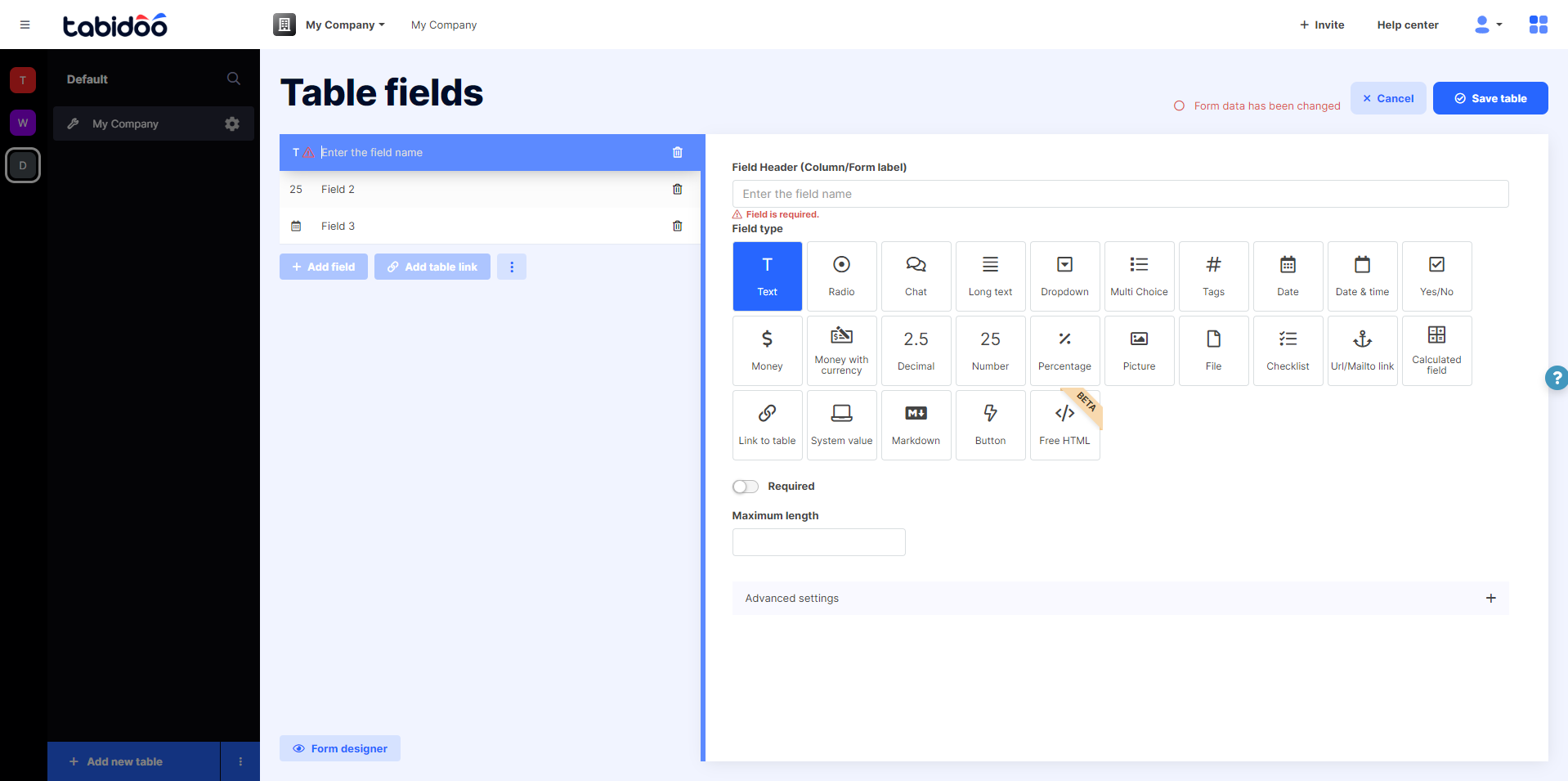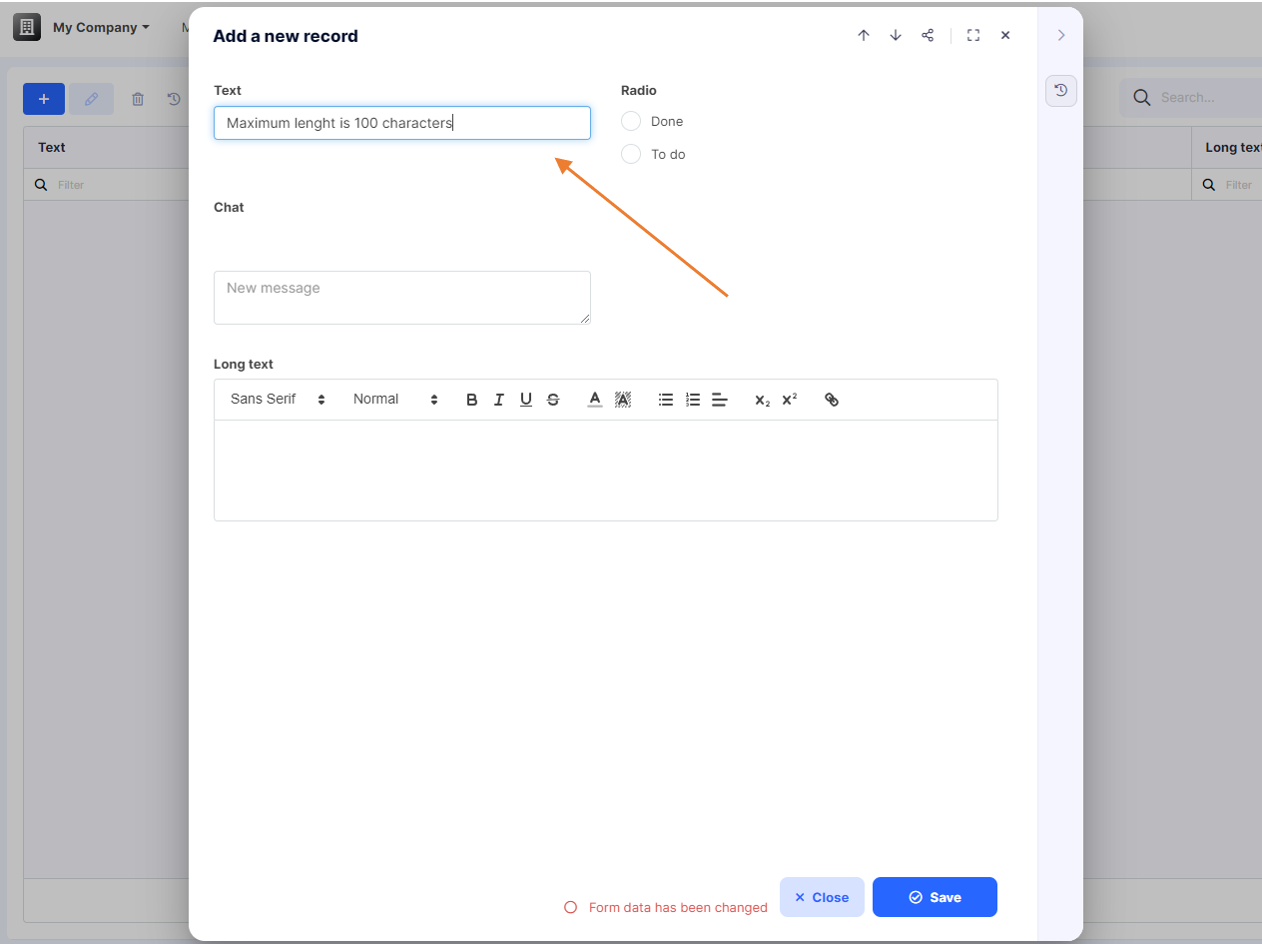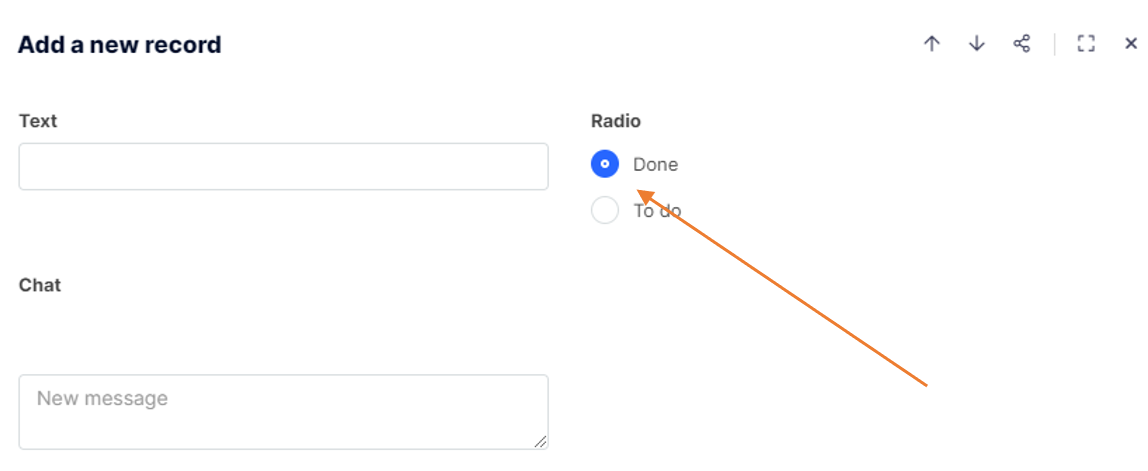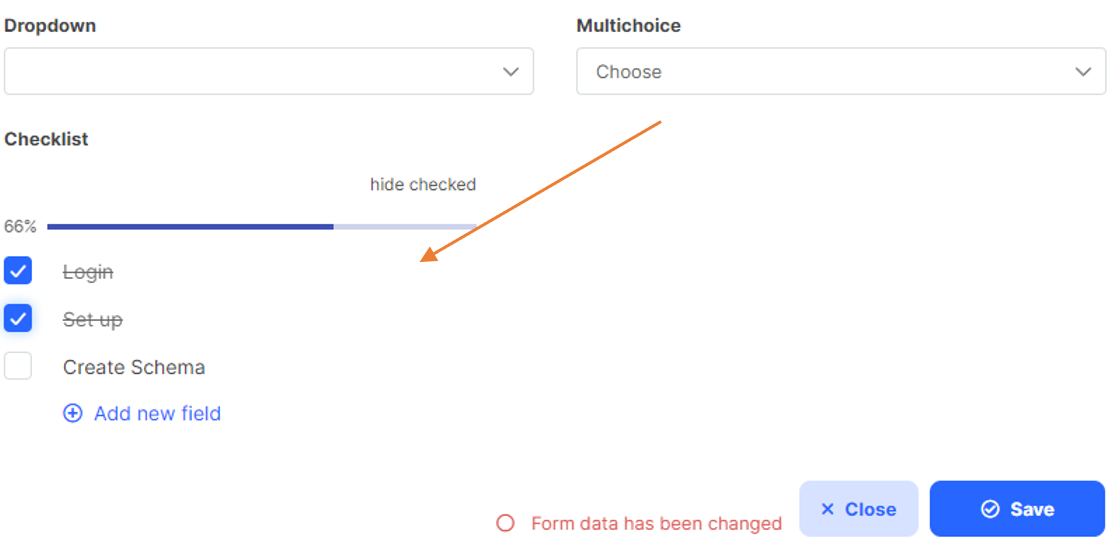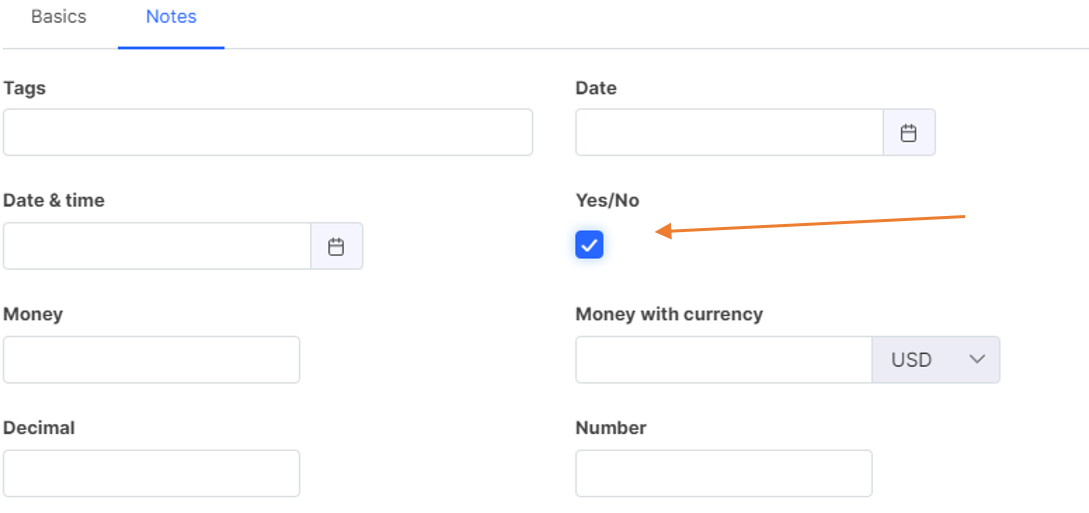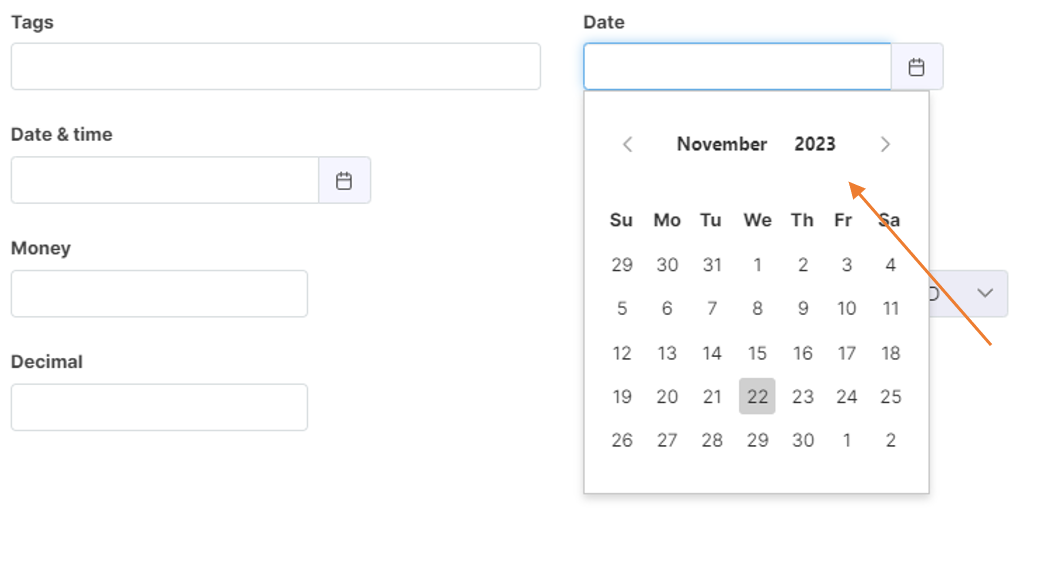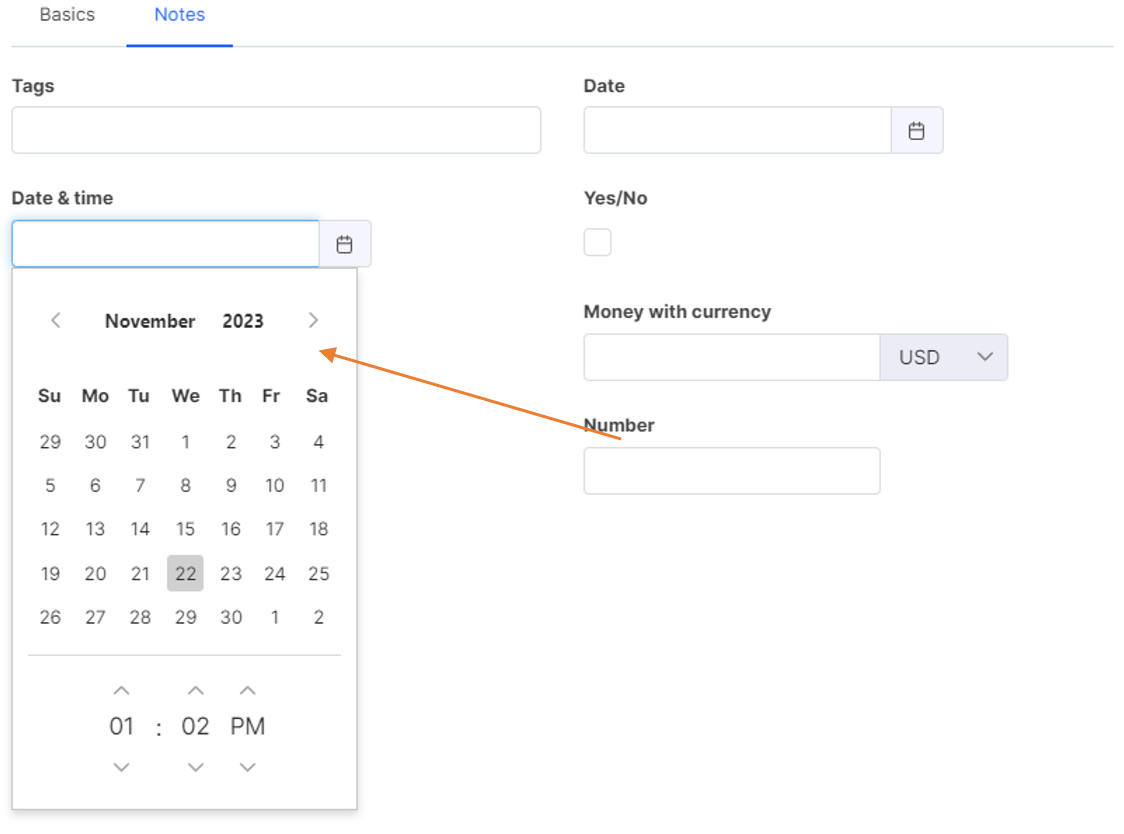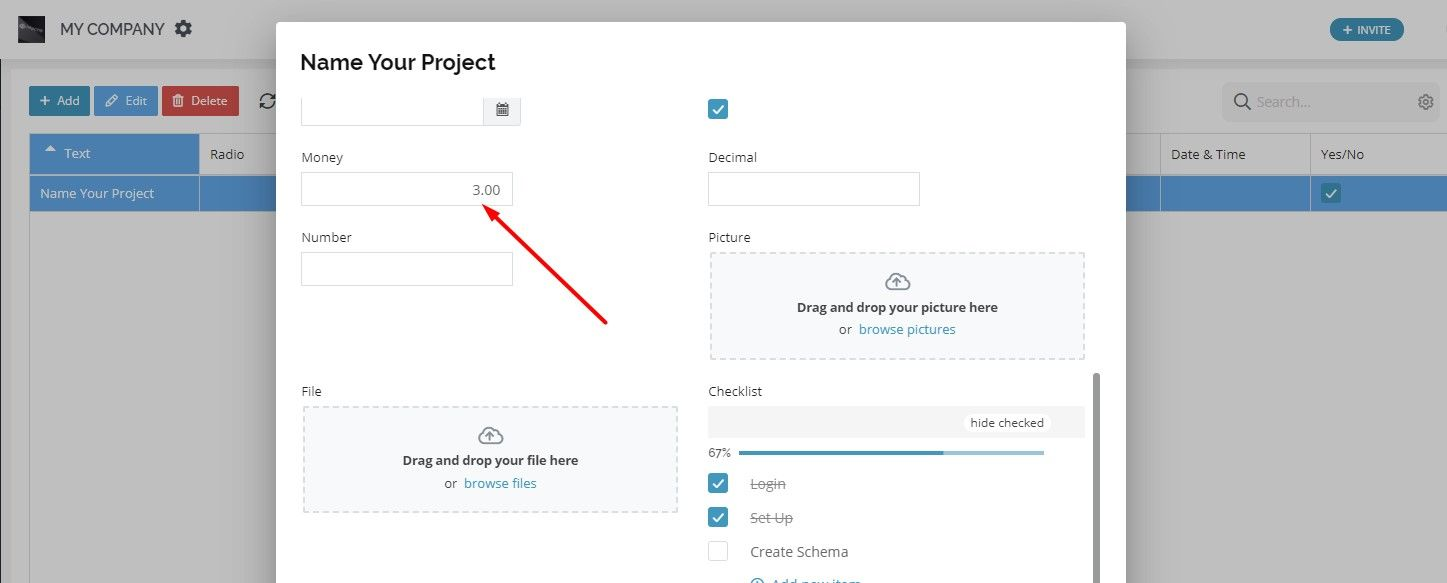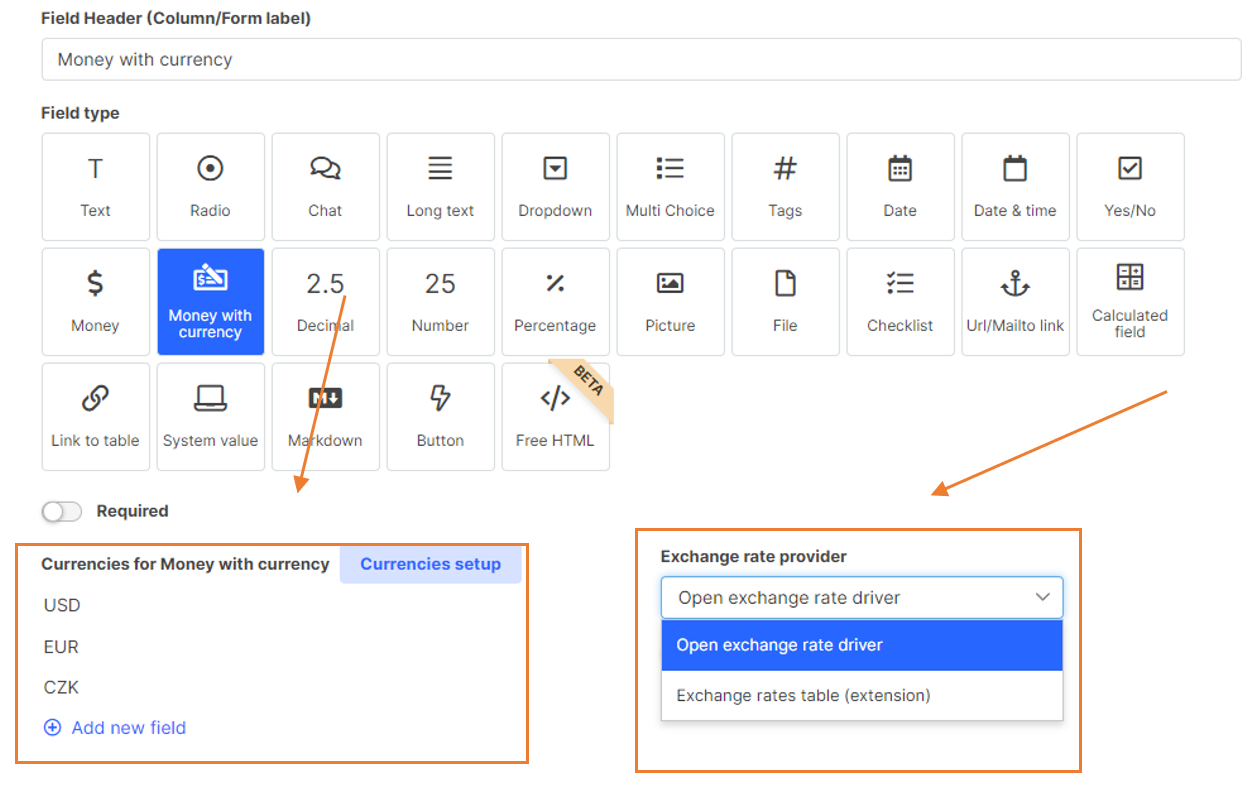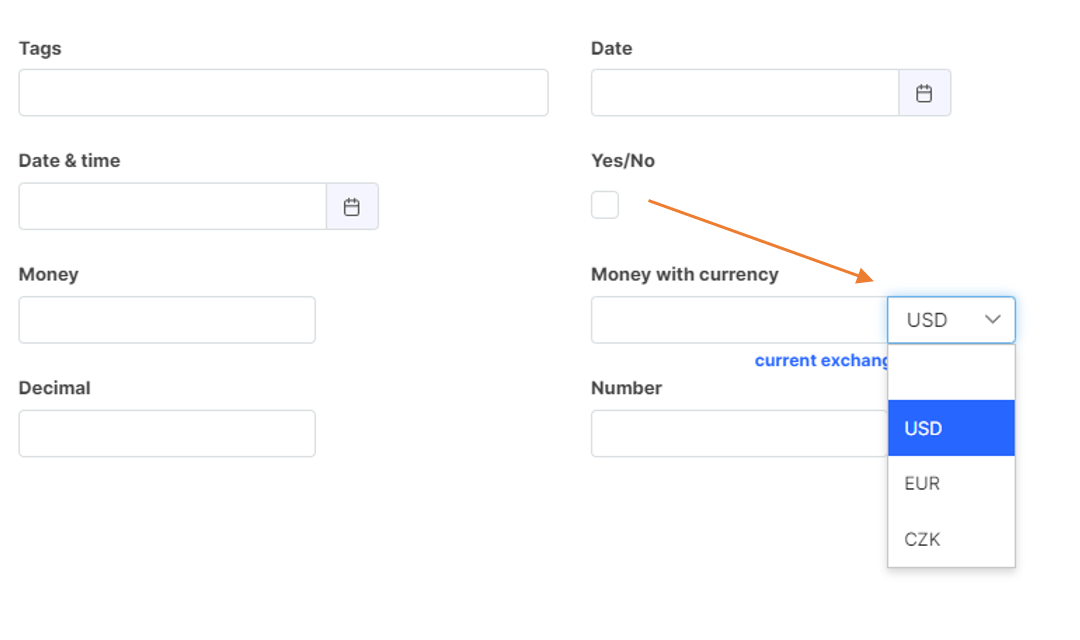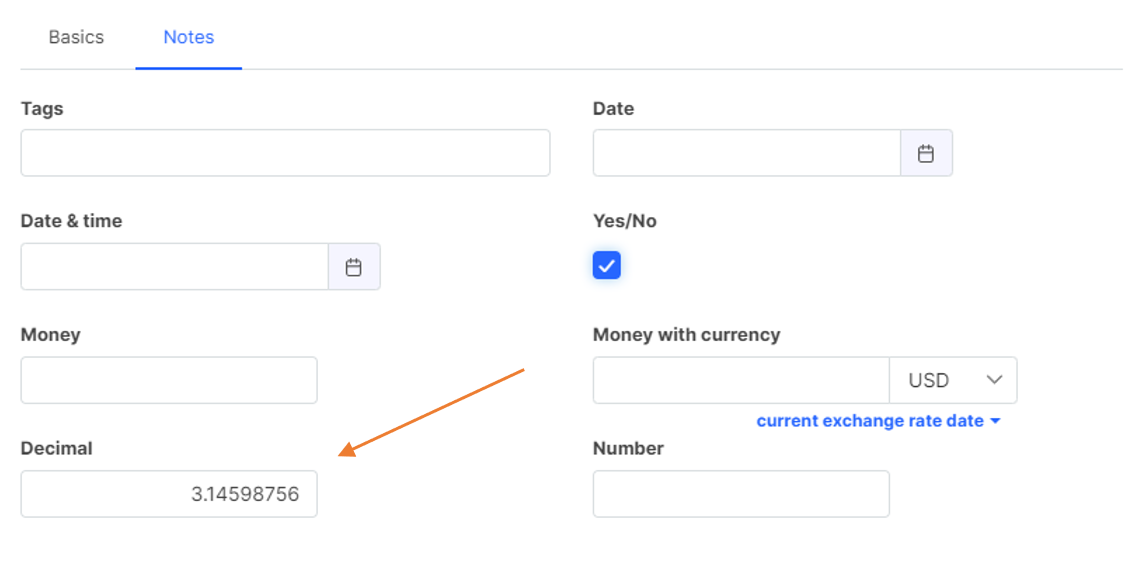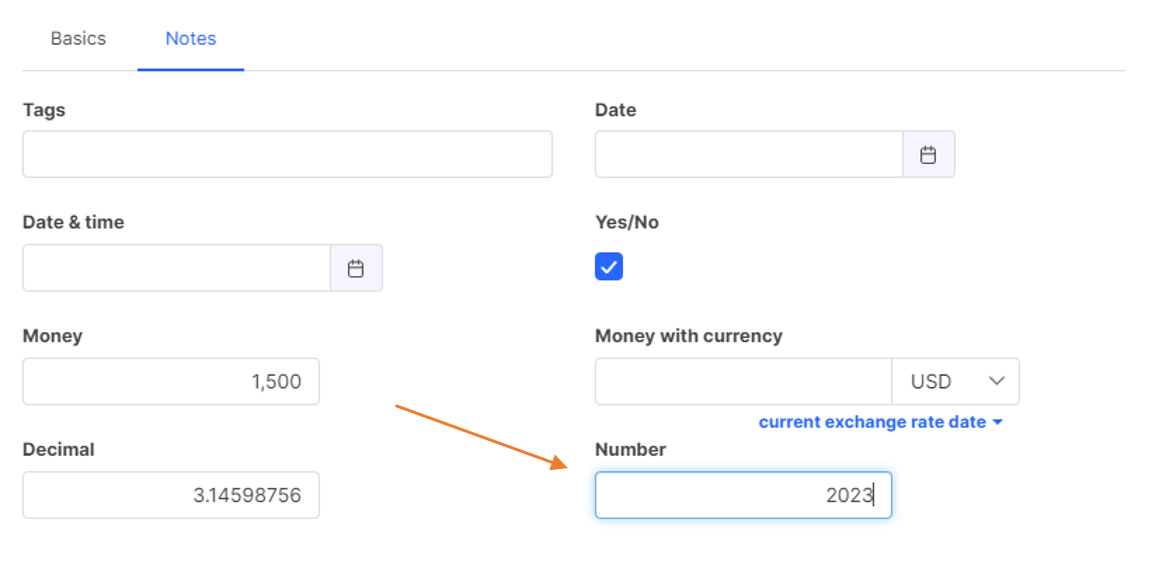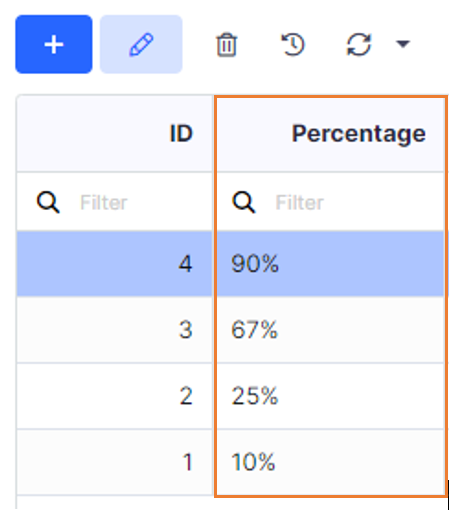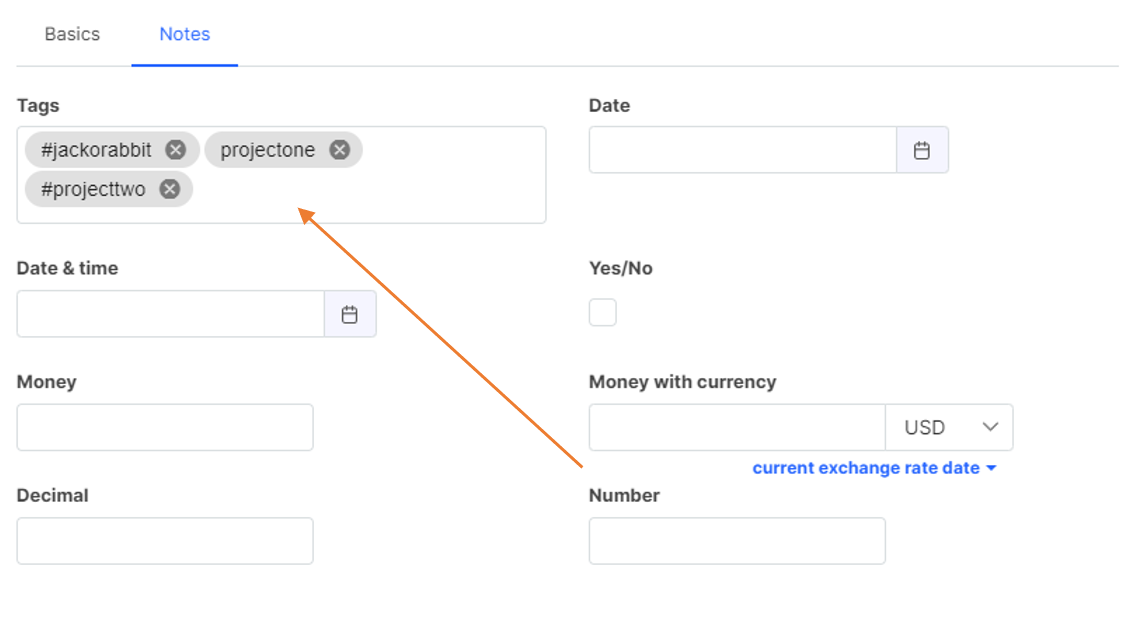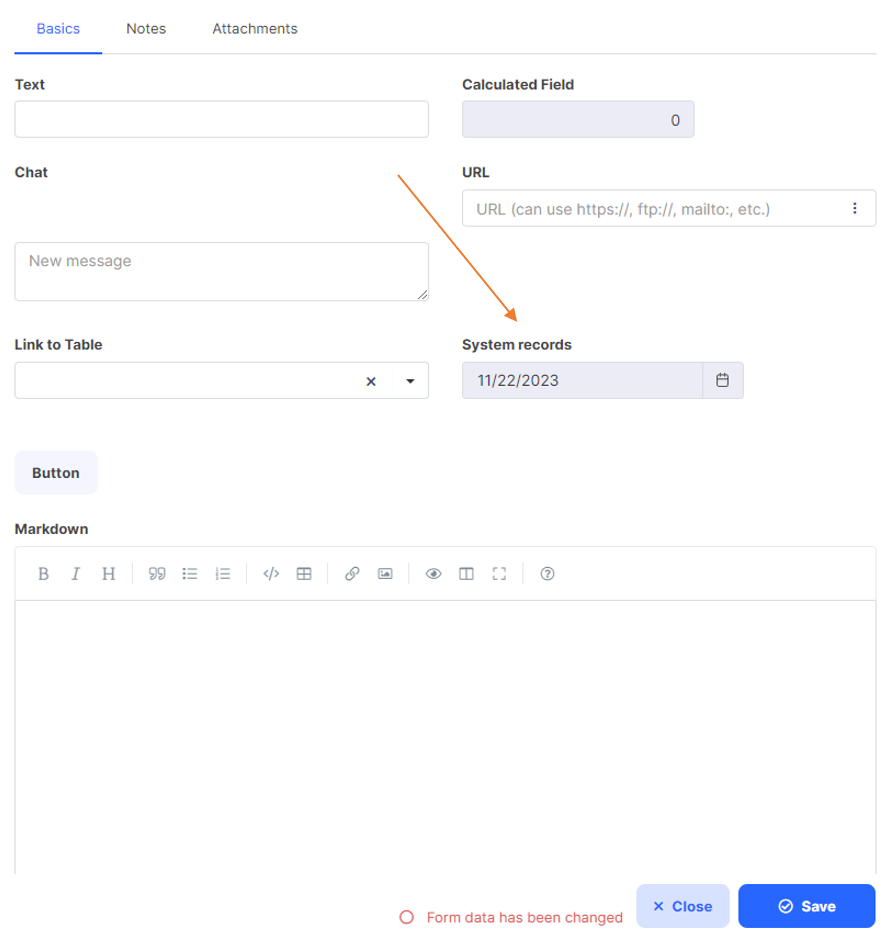Basic Fields
These fields cover standard data types such as text, numbers, dates, and files. They are ideal for building straightforward applications quickly, while keeping the setup intuitive for all users.
Types of entering data into tables in Tabidoo
In this chapter, we will take a look at the meaning of the individual items and how to use them.
Short text
Short text can be used to enter a title, type of product, or name. It can have a maximum of 100 characters.
Short text field in Tabidoo
The data type "Text" has a Custom Regex for Field Validation option at the Developer level.
To validate a phone number in the format "777 777 777," use the following regular expression:
\d{3} \d{3} \d{3}
- \d{3} matches three digits.
- Spaces are literal.
This regex ensures the phone number has three groups of three digits separated by spaces, e.g., "777 777 777".
Long text
It is a field for longer texts the length of which you can specify in the settings. It is used to insert formatted texts (such as in italics or underlined). It is suitable for the entry of long texts, such as product descriptions, procedures, or other records.
Long and formatted text in Tabidoo
Radio
Checklist with only one option.
Radio field for checking one of the options
Dropdown
This is a checklist with a single option in a different graphic design. If you need to have multiple checkboxes, it will help you differentiate between them and they will be presented in a more organized manner.
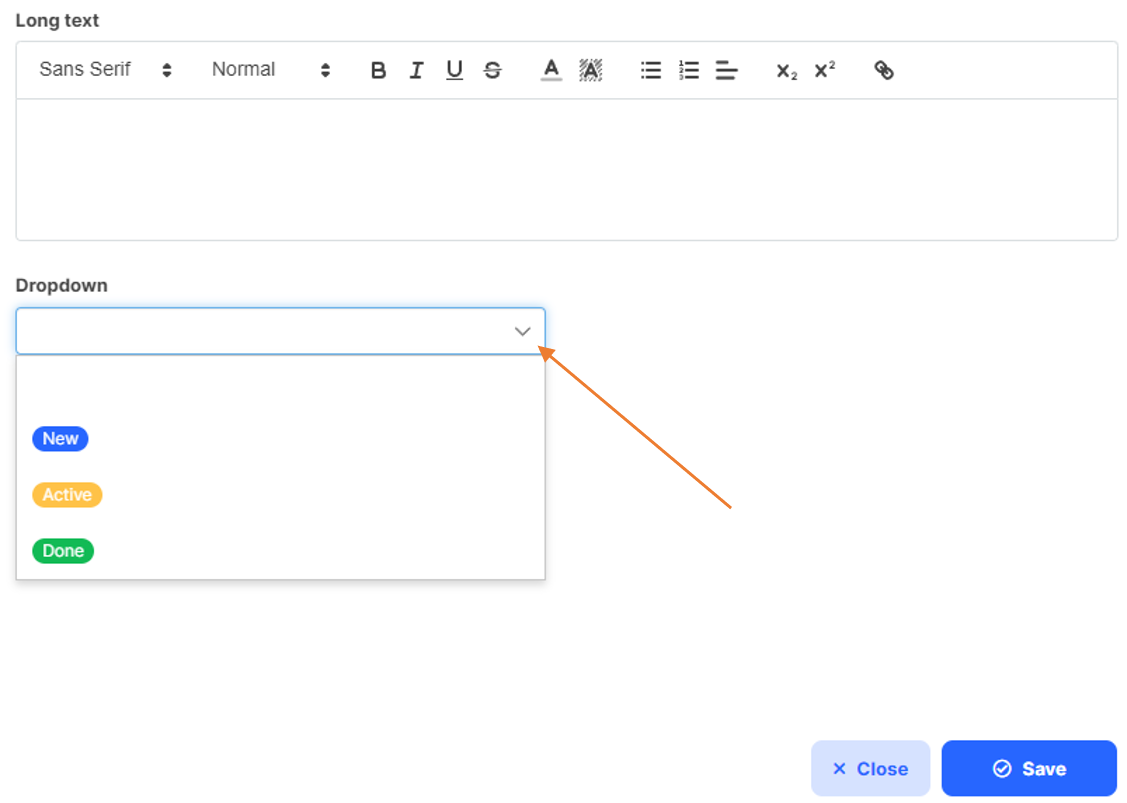
The dropdown field for checking one of the options
Multichoice
It is a checklist that allows you to select one or more options.
Multichoice field for checking one or more options
Checklist
It is a checklist that allows you to select multiple fields. It is ideal for creating lists of tasks, lists of items, or for displaying the completion of important project items.
Checklist field for creating lists
Yes/No
It is a single check box. It is ideal, for example, for recording whether an item has been completed or not.
Yes/No field for indicating completed items or validity of records
Date
It is a field for displaying the date in the selected format.
Date field in Tabidoo
Date and time
It is a field for displaying the date and time in the selected format.
Date and Time field in Tabidoo
Displays values according to the format defined in the application’s localization settings (date format, time zone, first day of the week). This format can also be further customized in the user profile settings (e.g., language, date/time format, 12h/24h clock).
Money
It is a field for entering numbers with a maximum of two decimal places (e.g., 3.14).
Money field for entering numbers with a maximum of two decimal places
Money With Currency
This field is used to enter and automatically convert money between currencies.
Field type Money With Currency for the automatic money conversion
Firstly, you have to add the currencies you want to work with by clicking on the "Add new field" button under the "Currencies for Money with currency" section. Secondly, you can choose to automatically load the exchange rate according to the internet provider or you can define your own rates in the Exchange Rates extension.
Exchange Rates extension can be extended with any additional columns. For example, the exchange rate type. For the input field, you can then restrict what type of rate is used for conversion.
Field type Money With Currency for the automatic money conversion
Once everything is set up, in the edit form you can enter a price and select the currency which will be then converted to the other predefined currencies and will appear in the grid. To turn off the Show in table option, use the Currencies setup.
Decimal
It is a field for entering a number with multiple decimal places (e.g., 3,14159265359).c
The decimal field for numbers with multiple decimal places
Number
It is a field for entering numbers with which you wish to work further (sort, compare, or evaluate them). You can also use the Short text item for numbers that you do not need to compare (e.g., EAN codes or telephone numbers).
Number field for working with numeric records
Percentage
The field is designed to make working with percentages easier.
Stored value = displayed value /100. So if you enter a value of 10%, the system will internally store the number 0.1 So it can easily be used in multiplication when calculating.
All calculations are done in JavaScript. When using in calculations, please familiarize yourself with the behaviors and rounding issues in JavaScript (0.1+0.2 ≠0.3).
Tags
It is a field for creating labels (tags). You can use it to tag topics, products, departments, or other data by which you want to filter.
Tags field for tagging and filtering records
Picture
It is a field for inserting an image. 1 field = 1 image. If you need more pictures, insert more fields.
Picture field for insertion of pictures and illustrations
Images of the following formats can be uploaded to Tabidoo: avif, jpg, png, jfif, bmp, ico, svg, webp, heic.
If files are attached via services such as Dropbox, Google Drive, or OneDrive, image thumbnails will not be displayed. These services provide only a link to the file, which typically requires logging into the respective service.
Files
It is a field for attaching one or more files each up to 50 MB in size. In case you want to attach more than one file, select the option "Allow multiple files" under the field type. To download attachments you need to save the form.
Files field for inserting files up to 1 MB. If files are attached via services such as Dropbox, Google Drive, or OneDrive, image thumbnails will not be displayed. These services provide only a link to the file, which typically requires logging into the respective service.
URL/ MailtoLink
It is a field for insertion of a link at https:// or a link to an e-mail box.
URL / MailTo field for linking a field with a website or e-mail
System Records
The System Records field provides key metadata about a record—such as who created or last modified it, the version number, or whether it contains GDPR-sensitive information. This data is useful for auditing, tracking changes, and ensuring compliance with privacy regulations.
System Records field for important records about work with the table
For more details about the available system fields, see the System Fields article.
If you later need relationships between tables, automated calculations, or custom scripts, take a look at the Advanced Fields section.

